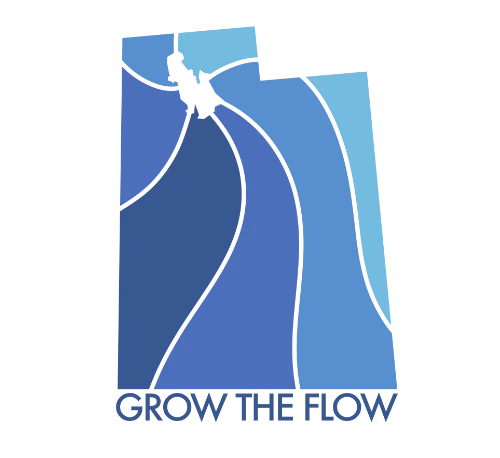- Form a Citizen’s Lake Lobby of more than 100,000 members from all backgrounds. No amount of ecological work or legal scaffolding can replace the need to rehabilitate our relationship with Great Salt Lake. Sustained stewardship begins with affection and a change in our societal norms1–4. Though public concern about the lake is extremely high5, citizen lobbying efforts have not been able to overcome the financial and political interests favoring water development. The Citizen’s Lake Lobby will reverse that political calculus by consolidating and diversifying public participation. We will mount a statewide campaign of personalized and persistent support focused on state-level officials but buttressed by local and federal initiatives. We will connect current water conservation leaders (e.g., strengthen the GSL Caucus) and cultivate new lake champions through relationship building, education, and public reporting.
- Reduce consumptive water use by 30–50%. Both surface and groundwater are severely overallocated in the Great Salt Lake watershed6–8. Depending on future weather and climate conditions9–11, consumptive water use must be reduced by a third to a half to reverse the lake’s decline. Our Policy and Research programs will develop and evaluate scenarios to increase water use efficiency, including policy frameworks (e.g., water markets, binding minimums, automatic emergency measures) and technical tools (e.g., next generation agricultural optimization, real-time monitoring, and improved hydrological modeling of the entire watershed). This actionable intelligence will inject the independence and agile assessment needed in a crisis environment.
- Grow average river flow to 2.5 million acre-feet per year by 2028. Water conserved in the Great Salt Lake watershed will only benefit the lake if it reaches the lake. Though a range of “minimum inflows” have been estimated9,10,16, it is likely that Great Salt Lake needs an average of 2.5 million acre-feet of river discharge each year to begin its rebound. 2028 is the target turnaround date when water conservation and shepherding will let the lake’s level begin to rise. This goal requires expanded water accounting throughout the watershed and new policies to shepherd conserved water to the lake.
- Restore lake level to above 4,200’ by 2033. If not for water overuse and climate change, Great Salt Lake would fluctuate around its long-term natural elevation of 4,207’7. Replenishing the lake to an elevation above 4,200’ will restore most of its ecological functions and ecosystem services, including protecting air quality, sustaining 80% of Utah’s wetlands, supporting $2.5B in economic activity annually, and regulating local climate17. Given the projected declines in river flow from climate change10,11, we need to rapidly restore the lake’s buffer by reaching 4,200’.
Sources:
1. Berry, W. The Way of Ignorance: And Other Essays. (Counterpoint, 2006).
2. Williams, T. T. Opinion | I Am Haunted by What I Have Seen at Great Salt Lake. The New York Times (2023).
3. Chapin, F. S. et al. Earth stewardship: Shaping a sustainable future through interacting policy and norm shifts. Ambio (2022) doi:10.1007/s13280-022-01721-3.
4. Kimmerer, R. W. Braiding Sweetgrass: Indigenous Wisdom, Scientific Knowledge and the Teachings of Plants. (Milkweed Editions, 2013).
5. Endter-Wada, J., Welsh, L. & Kettenring, K. Future of Great Salt Lake Survey. (2023).
6. Young, Z. M., Kreemer, C. & Blewitt, G. GPS Constraints on Drought-Induced Groundwater Loss Around Great Salt Lake, Utah, With Implications for Seismicity Modulation. Journal of Geophysical Research: Solid Earth 126, e2021JB022020 (2021).
7. Wurtsbaugh, W. et al. Impacts of Water Development on Great Salt Lake and the Wasatch Front. 9 https://digitalcommons.usu.edu/wats_facpub/875/ (2016).
8. McDermid, S. et al. Irrigation in the Earth system. Nat Rev Earth Environ 1–19 (2023) doi:10.1038/s43017-023-00438-5.
9. Abbott, B. et al. Emergency measures needed to rescue Great Salt Lake from ongoing collapse. 35 DOI: 10.13140/RG.2.2.22103.96166 (2023) doi:10.13140/RG.2.2.22103.96166.
10. Great Salt Lake Strike Team. Great Salt Lake policy assessment. 36 https://gardner.utah.edu/wp-content/uploads/GSL-Assessment-Feb2023.pdf?x71849 (2023).
11. Williams, A. P., Cook, B. I. & Smerdon, J. E. Rapid intensification of the emerging southwestern North American megadrought in 2020–2021. Nat. Clim. Chang. 1–3 (2022) doi:10.1038/s41558-022-01290-z.
12. Rockström, J. et al. Safe and just Earth system boundaries. Nature 1–10 (2023) doi:10.1038/s41586-023-06083-8.
13. Huggins, X. et al. Groundwater Connections and Sustainability in Social‐Ecological Systems. Groundwater gwat.13305 (2023) doi:10.1111/gwat.13305.
14. Wine, M. L. & Laronne, J. B. In Water Limited Landscapes, an Anthropocene Exchange: Trading Lakes for Irrigated Agriculture. Earth’s Future 8, e2019EF001274 (2020).
15. Abbott, B. W. et al. Human domination of the global water cycle absent from depictions and perceptions. Nature Geoscience 12, 533–540 (2019).
16. Tarboton, D. et al. A Convergence Approach to the Drying Great Salt Lake. (2022).
17. UDNR. Utah Department of Natural Resources Great Salt Lake Characteristics Matrix | U.S. Geological Survey. https://www.usgs.gov/media/images/utah-department-natural-resources-great-salt-lake-characteristics-matrix (2022).
